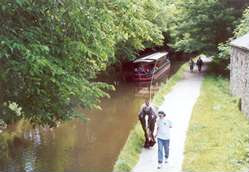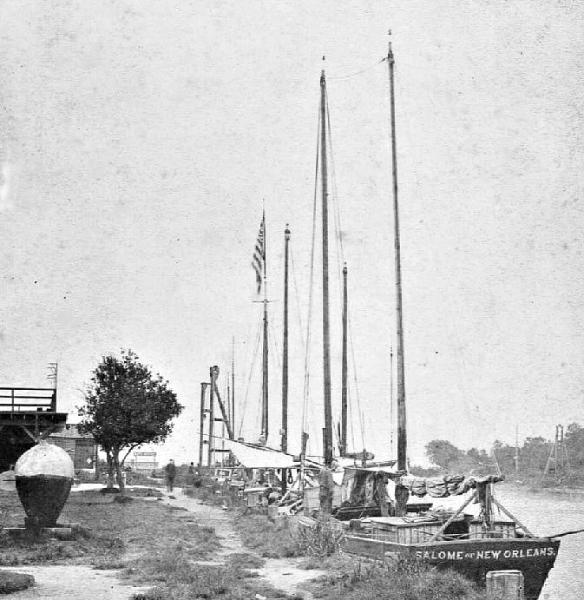| The Old Bayou St. John Towpath |

What remained of Bayou St. John's once busy towpath is shown in the picture above, at the
point on the Bayou where Spanish Fort Amusement Park was located. I'm not sure of the date of
the photo, but it had to have been before 1900, because the picture below was taken at the
same place in 1900 and all trace of the towpath has disappeared. The towpath was in use for
well over a century, as boats made their way from Lake Pontchartrain to New Orleans, where the
bayou ended not far from the Mississippi River.
Towpaths, where a team of men or a man guiding a horse walked along a body of water pulling a
boat, were common all over the world for the better part of two hundred years. A horse can
move about fifty times as much weight in a boat as it could in a cart on the roads of the day. It
was this efficiency, some say, which inspired the development of the canal system in the 18th
century.
Boats can only transport goods when they move. Using the current on inland rivers would
mean only one-way traffic; and, on canals, there was no current at all. Sails were only useful if
the wind was in the right direction and if the river was straight. Boatmen could wait for days for
a good wind or hire a group of men or a man and a horse to tow his barge or boat upriver, or
down canals or bayous.
Even after the introduction of steam and motor boats, horse-drawn boats continued in use in
some locations, until the middle of the 20th century. But, eventually, towing became obsolete.
Since then, many towpaths have been converted to multi-use trails and are still called towpaths,
even though they haven't been used as such for a very long time.
By the way, the object on the left in the photo above is a Civil War era submarine. You can read
more about the sub here.
The photograph above was taken by New Orleans photographer George Francis Mugnier.
point on the Bayou where Spanish Fort Amusement Park was located. I'm not sure of the date of
the photo, but it had to have been before 1900, because the picture below was taken at the
same place in 1900 and all trace of the towpath has disappeared. The towpath was in use for
well over a century, as boats made their way from Lake Pontchartrain to New Orleans, where the
bayou ended not far from the Mississippi River.
Towpaths, where a team of men or a man guiding a horse walked along a body of water pulling a
boat, were common all over the world for the better part of two hundred years. A horse can
move about fifty times as much weight in a boat as it could in a cart on the roads of the day. It
was this efficiency, some say, which inspired the development of the canal system in the 18th
century.
Boats can only transport goods when they move. Using the current on inland rivers would
mean only one-way traffic; and, on canals, there was no current at all. Sails were only useful if
the wind was in the right direction and if the river was straight. Boatmen could wait for days for
a good wind or hire a group of men or a man and a horse to tow his barge or boat upriver, or
down canals or bayous.
Even after the introduction of steam and motor boats, horse-drawn boats continued in use in
some locations, until the middle of the 20th century. But, eventually, towing became obsolete.
Since then, many towpaths have been converted to multi-use trails and are still called towpaths,
even though they haven't been used as such for a very long time.
By the way, the object on the left in the photo above is a Civil War era submarine. You can read
more about the sub here.
The photograph above was taken by New Orleans photographer George Francis Mugnier.

| A horse-drawn boat as tourist attraction in present-day England. |
